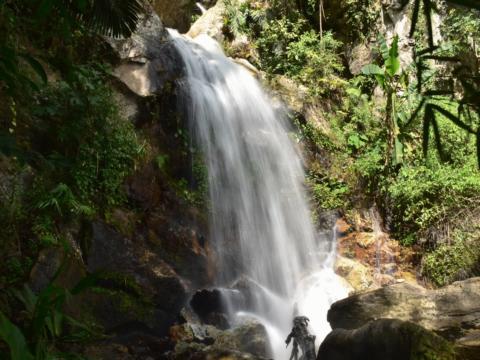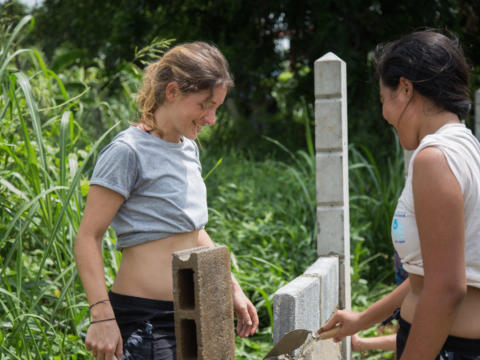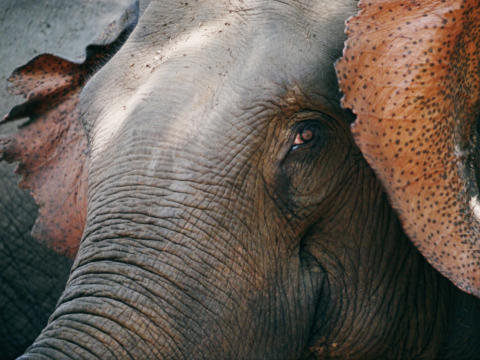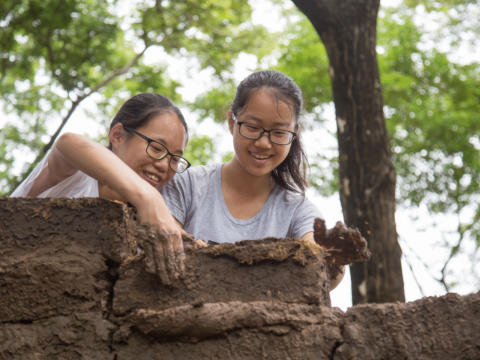Only 780€ per week!
Gibbon Encounter
Mae Sot - Thailand
Gibbon Encounter
Mae Sot - Thailand
Care for gibbons by preparing their food, feeding them, cleaning their enclosures and providing them with affection in a sanctuary setting.
Halfway in-between a wildlife sanctuary and the jungle, the gibbon project offers the chance to see these intriguing creatures up close and in the flesh. The gibbons here have been rescued from neglectful owners or adopted from families who could no longer care for them.
Program Description
The essential focus of this project is to rescue gibbons that have been badly treated, abused or injured, especially from people who make money off them by using them as tourist attractions and “photo opportunities”, charging for taking photos with them. These animals have been previously taken from jungles as newborns, and in order to be able to make them come down from the trees, their parents are shot.
The sanctuary aims to rescue these gibbons and provide them with a safe home as they are unable to return to the forest after such a long time.
As a participant in this project, you should provide the gibbons with the love and care that they require.
Also known as “the smaller apes”, gibbons are one of the most endangered of ape species due to loss of their habitat as well as poaching and illegal trade for tourism purposes. Moreover, gibbons are one of the few species that remain monogamous. If their partner dies, they are unlikely to mate with another gibbon, giving little to no chance of new babies.
The main activities will be to feed the gibbons, clean their enclosures and perhaps most importantly, to give them love, attention and to “socialise” with these beautiful and charming creatures. This will help them get used to interacting with human beings as they can no longer be released into the wild. Their quality of life is of paramount importance to this project. The gibbons will remain in the sanctuary for the duration of their lives, as they would be at extreme risk if returned to the wild.
The sanctuary is aimed at gibbons. However, it does not reject any animal in need! Over the previous years, other furry friends in need have made it here, including over 20 macaque monkeys, a bear, two jackals and a even a bearcat.
Surrounded by lush nature, the center creates an environment that resembles that of their natural habitat, the gibbons live in huge cages which are interconnected by wired tunnels in order to keep them safe while at the same time giving them as much space as possible to do what they do best: swing! These creatures are considered some of the world’s best acrobats and they are able to jump from tree to tree as far as 15 meters apart!
A compassionate attitude towards animals is of course required for this project! You should leave this project knowing that you have helped, cared for and given love to these deserving and fascinating creatures.
Some of the activities you will be involved with include:
Preparing Food
This is done twice a day in the morning and the afternoon. You will assist in preparing, distributing and feeding of the gibbons.
Cleaning and Tidying Enclosures
It’s a dirty job…. but someone’s got to do it! This basic hygiene procedure is carried out daily. Keep in mind that you will not be allowed inside the cage with gibbons for safety reasons and the tidying is done only underneath the cages.
Socialising with the Gibbons
This may sound like a straightforward job, but the value of it cannot be underestimated. Many of these gibbons have developed a fear of humans due to bad and negligent treatment. Making them comfortable around humans is crucial through activities such as “fluffing”, imitating their calling “OoooooOOO”, and holding their hands.
Aims & Objectives
- Provide a safe and comfortable environment for gibbons
- Make the gibbons comfortable with human interaction and to establish mutual trust
- Give you invaluable, practical experience in working with animals
- Assist the local staff by providing an extra hand
Schedule
Sunday
You will join an overnight transfer to the program location from Singburi.
Monday
If this is your first day, it will consist of a full introduction. This is to raise awareness of your role during the project.
Any direct contact with the Gibbons MUST be done with the supervision of the staff. Each gibbon is different and you must first get acquainted with them before attempting to make contact with them.
Tuesday to Friday
This is where you will be unleashed into your full time role at the project. A gibbon’s day starts early, and so will yours, as we need to wake up early to prepare their breakfast. But don’t worry – you are unlikely to need to set up an alarm clock as the gibbons produce a distinctive calling as soon as they wake up (it’s so loud that can be heard from kilometers away!).
Your typical daily duties will include: cleaning the gibbon enclosures. At times, the sanctuary receives visitors (although not often) who want to meet the gibbons for a few hours. In this case, you might be asked to show them around.
Moreover, those with the proper background may assist with medical procedures, if and when they occur.
Your day will end at around 15:30 (the gibbons go to bed quite early), so your afternoons are free to explore the sanctuary, read a book (there are many English books available upon request and a TV room with a wide selection of DVDs), learn more about gibbons or simply relax before dinner time.
Saturday
End of program. You get taken to Mae Sot bus station around 07:00 or transferred to Singburi for further programs unless you stay in Mae Sot.
Note: This schedule can be changed and/or amended depending on weather conditions, local conditions and unforeseen circumstances.
Participant Criteria & Requirements
Standard Requirements
Minimum age: 18
Maximum age: –
Minimum English level: Basic
CRB required: On Signup
Passport copy required: No
Resume copy required: No
Required qualification: None
Additional Requirements
- Rabies vaccinations are strongly advised for this program
Additional Equipment
- Warm clothes as the temperature can cool down a lot during the evening in this area of Thailand
Location
You will be located in one of the most elegant, sparse and relaxed areas of Thailand. Located outside of Mae Sot, the gibbon sanctuary will provide you with peaceful surroundings amidst lush jungle and mountain landscapes. You are unlikely to need an alarm clock here – as the gibbons wake up between 5 and 6 am and call out (warning: they are loud!)
About the Accommodation
You will be living in beautiful wooden houses that meet typical western standards.
There are books in English available as well as a TV room with a varied selection of DVDs which you can enjoy during your spare time.
Food Arrangements
Three homemade meals are provided per day in the house (Thai and Western style). However, at times, you might be taken out to a nearby local restaurant.
There is a mini kitchen with a refrigerator, so feel free to bring snacks. A good idea since there are no shops nearby, so make sure you bring anything you might need!
Facilities
Due to its rural location, there are no ATMs or shops in the area. You should not need much money as most things are provided on site.
Activities & Events
No scheduled activities outside the program.
Sights & Surroundings
This location is based in the jungle and so it is very rural. This is perfect however for those who enjoy trekking!
A 50 minute drive away is the town of Mae Sot, which shares a border with Myanmar and despite being quite small, it does have an airport, making it a good place to connect with the rest of Thailand via domestic airlines.
Transportation
From this location we provide free transport to your next program at the following location(s):
- Akha Village Chiang Rai
- All around Thailand
- Around Thailand
- Hua Hin
- Kaeng Krachan
- Kanchanaburi
- Singburi
- Suphan Buri
- Train Track Northern Thailand
- Trunk to the South
- Umphang
- Udon Thani
- Wang Nam Khiao
Quick Facts
Name: Kingdom of Thailand
Population: 67 million
Capital: Bangkok
Language: Thai
Currency: Baht (THB)
Time zone: ICT (UTC +7)
Country Information
From trekking in the beautiful mountains of the north to enjoying the glorious beaches in the south and experiencing the hustle and bustle of the metropolis that is Bangkok, Thailand is certainly not a country that lacks variety.
Whilst it really is at the heart of Southeast Asia, bordered by Myanmar, Laos, Cambodia and Malaysia, its cultural identity remains very unique. As the only country in Southeast Asia to avoid European powers, the Thai are proud to refer to themselves as ‘The Land of the Free’ and many tourists might also know it as ‘The Land of Smiles’ due to its friendly people.
Climate
The majority of the country is home to a tropical savanna climate which consists of wet and dry seasons of a roughly equal length. The climate can be divided into three distinct seasons:
- Dry season: November – end of February. During this period, precipitation is at its lowest but so are the temperatures. This said, ‘low temperatures’ are of course relative and the difference is not in fact very different at all in the South. It is only if you will be visiting the northern mountains that you might need to bring some warmer clothes as temperatures can fall as low as 5°C. This period is, not surprisingly, the most popular time to visit Thailand and tourism peaks around Christmas and New Year as well as Chinese New year. Flights and accommodation at this time can be more expensive.
- Hot: March to June. During this time Thailand reaches its hottest temperatures (as high as 50°C).
- Rainy: July – October. This is when the tropical monsoons begin to arrive, peaking in September. Although this is indeed rainy season, it doesn’t mean that it rains non-stop. Storms can clear up very quickly, but when it does rain, heavy flooding is not rare.
Culture
A significant feature of Thai culture is its primary religion: Buddhism. Theravada Buddhism is supported by the government and practiced by an estimated 95% of its population. Thailand not only boasts tens of thousands of beautiful temples, but you will notice that a lot of Thai people have miniature Spirit Houses on their front yards because they believe that the household spirits live in them and they make offerings to them to keep the spirits happy.
Another feature of Thai culture is the wai greeting, which is essentially a slight bow with palms pressed together in a prayer-like manner to show respect. This can be compared to the Indian namasté. Things to know about this:
- The higher the hands in relation to the face and the deeper the bow, the more respect is shown.
- It is made before formally entering/leaving a house
- It can also be made as a sign of gratitude or apology
- You do not make the greeting to those who are younger than you unless you are returning the wai.
- The gesture is normally accompanied with the phrase “sawadee (krap/ka)” (“krap” if you are male and “ka” if you are female)
- A corporate wai (made by cashiers etc) can be returned with a smile or a nod
The major festival in Thailand is Thai New Year, known as Songkran. It is celebrated on the 13th-14th April of every year. It is a festival that concludes the dry season and involves a lot of water throwing!
Gastronomy
Thai cuisine is very nutritious and alongside its plentiful use of rice, it generally contains fresh vegetables and white meats like chicken and fish. Thai people love spicy food but do not fear if you do not, just say ‘mai pet’ when you order. However, the flavors are not only about the spice, as many people believe. Thai food can be slightly salty, sour and/or sweet, so there really is something to suit everyone’s palate.
Transportation
Transport in Thailand is very varied and there isn’t one ‘main way’ to travel. Buses dominate long distance journeys. Travel in thailand is cheap and even domestic flights are a worthwhile consideration for long distance journeys, especially with the expansion of low-cost airlines.
Taxis, tuk-tuks and vans are also common modes of transport, but tourists must be wary about being overcharged. If in doubt, always ask that the taximeter be switched on to avoid overcharging.





